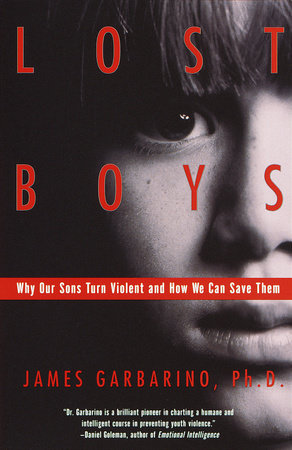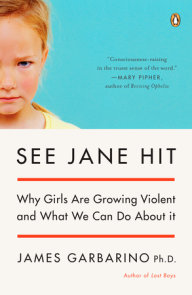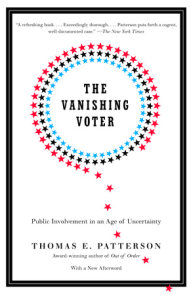READERS GUIDE
The questions, discussion topics, and suggested reading list that follow are intended to enhance your group’s reading of Dr. James Garbarino’s Lost Boys: Why Our Sons Turn Violent and How We Can Save Them. We hope they will provide you with new ways to address the many vitally important issues raised in this remarkable, compassionate study of youth violence and what we can do about it.Introduction
The last few years have seen American youth violence reach epidemic proportions, spreading out from urban war zones into apparently peaceful middle-class communities such as Littleton, Colorado and West Paducah, Kentucky. As the haunting images of one school massacre after another are imprinted on our national consciousness, it’s becoming clear that no matter how much we protect our kids, chances are they go to school with troubled boys capable of pulling triggers. What has caused this terrible trend, and how can we avert it? Building on twenty-five years of experience working with violent children, Dr. James Garbarino demonstrates that violent teenagers follow specific patterns of behavior and give recognizable warning signals. With knowledge and foresight, there are things we can do to prevent tragedy and save lives. Full of insight, vivid individual portraits, practical advice, and cautious hope, this is one of the most important and original books ever written about boys.Questions and Topics for Discussion
1. Garbarino has spent his career trying to understand why kids turn to violent crime. "I know that many individuals are desperate for answers," he writes, "but do we as a society really want to know? Sometimes as I listen to people talk about violent youth, I doubt that they really want to understand" [p. 20]. Do you believe that as a society we want to find answers, or would we rather not understand the reasons for youth violence? Why might we choose to turn our backs on this subject? Why has the American public largely chosen to ignore a crime rate that blights the lives of inner-city children?
2. Much of Lost Boys deals with the emotional dissociation resulting from pain and shame, and the desensitization that follows from such dissociation. Does Garbarino’s explanation make sense to you? Can you see the same pattern in people, both young and old, who are not violent? Would you say that dissociation and desensitization are to some degree characteristic of our culture? Why or why not?
3. How does our culture define masculinity, and how do our ideals regarding masculinity contribute to violent behavior in young boys? Which of these ideals are the most destructive? Which, on the other hand, might be helpful in assisting boys to grow into healthy and productive men? How does Garbarino define "androgyny" [p. 169-70], and how might this concept help our children—and ourselves?
4. What does the psychologist Harry Stack Sullivan mean when he says that "human behavior is more simply human than otherwise" [p. 94]? What qualities, both good and bad, go into being human? What part does the "dark side" play in human nature? Is the "dark side" implicit in our very beings, or is it learned or cultivated?
5. How can we, as individuals and as a society, foster what psychologist Dan Goleman has called "emotional intelligence"? What values and characteristics make for emotional intelligence, and in what ways does our culture undermine these?
6. Garbarino discusses what he calls a "betrayal by adults" [p. 109]: adults, he says, have not kept their part of the social contract; they are not caring for children, and they are not in control of them. What, if any, evidence of this betrayal do you see in the culture at large and in your own community in particular? How has the situation changed since you were a child? Do you think that children and young people are justified in withholding their trust from adults?
7. Do you agree with Garbarino’s thesis that "morality" is a relative term, highly dependent on context, and that extremely violent youths tend not to be immoral or amoral but simply operate by different moral standards, standards determined by the culture they have created? What are these standards? In what ways are they fatally at odds with the moral standards that American citizens uphold (or claim to)?
8. The experiences of kids in suburban and rural high schools are very different from those in urban areas. But what experiences do these groups of teenagers share? In what ways are contemporary middle-class kids under greater pressure, and more likely to act violently, than their counterparts of thirty years ago? What factors have caused this situation, and how might it continue to evolve?
9. Do you agree with Garbarino that trying teenagers as adults in ordinary criminal courts is absolutely wrong? What about executing teens? Have Garbarino’s arguments influenced your thoughts on the death penalty? On the criminal justice system? On the juvenile justice system?
10. One of the boys Garbarino works with says that anyone would commit violent acts if placed in the circumstances under which he and so many others live their lives. Do you agree? Do you see the actions of these boys as a strategy of adaptation to their surroundings? As a way of gaining control? Or simply as license to behave immorally?
11. Garbarino believes that television has caused our youth great emotional damage and desensitization to violence. How would you respond to the question he poses: "Are we willing to accept tragedies like those in Jonesboro, Paducah, and Springfield as part of the cost of being an American, or are we willing to pay the price for a less violent society by depriving ourselves of violent imagery on television and in the movies, at least so far as children are concerned" [p. 199]? If you have children, will this book affect your monitoring of their television viewing, or even influence you to get rid of the television set altogether? What about interactive "point-and-shoot" video games?
12. Some Americans believe that the sale of guns should be heavily controlled or even made illegal; others argue that "guns don’t kill, criminals kill" [p. 201]. What position do you take on this issue? What relevance, if any, does the Constitution’s guarantee of the right to bear arms have on the question? What do violent crime statistics from other countries imply about the effect of easy access to firearms?
13. Garbarino contends that as a society "we are politically incapacitated by our distrust of public institutions" [p. 204]. How does this distrust manifest itself in the way we deal with children and youth? How does it manifest itself in other areas of our lives? What events in our history might have caused such distrust? To what extent must we overcome it if our children are to grow up safe and happy? What public institutions can and must be given power?
14. Do you agree with Garbarino’s theory that large high schools are potentially dangerous for teenagers? What do your own experiences, or those of your children or friends, bring to bear on this question?
15. "Some people in the legal system and in the larger society scoff at the idea that being abused as a child should play a role in evaluating and judging a boy who has committed a violent crime, and use the term ‘abuse excuse’ to refer to this line of defense" [p. 217]. Is the term sometimes used too loosely? Have you ever been inclined to agree with these skeptics? Has this book changed your opinions on the subject? Is there any good way to legally define "abuse"?
16. Garbarino believes that the current "boot camp" style of rehabilitation is "most unsuited" to violent boys, given where they come from psychologically and who they are developmentally and spiritually. Might "boot camp" rehabilitation have a good effect on other types of troubled or difficult teens, or is it entirely flawed as a model? Do you like Garbarino’s alternative "monastery model"? What elements of this model might be most effective? Can you find any flaws in it?
17. Why is the notion that society should lock up these boys and throw away the key gaining success in so many state legislatures? Do voters and legislators really believe this is the only solution, or are they simply unwilling to take on the onerous, expensive task of true rehabilitation?
18. What flaws has Garbarino pointed out in contemporary "family values," "just say no" political rhetoric? Has this book changed your response to this sort of rhetoric?






















